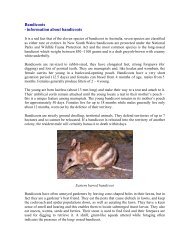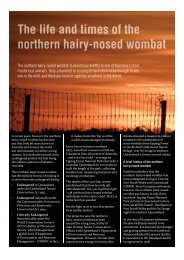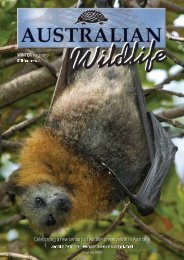Wildlife Preservation Autumn 2012.indd - Wildlife Protection Society ...
Wildlife Preservation Autumn 2012.indd - Wildlife Protection Society ...
Wildlife Preservation Autumn 2012.indd - Wildlife Protection Society ...
You also want an ePaper? Increase the reach of your titles
YUMPU automatically turns print PDFs into web optimized ePapers that Google loves.
Helena gum moth (Opodiphthera Helena). With a wingspan of 170mm, this amazing moth is<br />
unmistakable<br />
Nightjar (Aegotheles cristatus). This bird species is Australia’s smallest nocturnal bird. They live in<br />
hollows and often take up refuge in possum nest boxes<br />
Growling grass frog (Litoria reniformis). Once a common species, the growling grass frog is now<br />
listed as endangered<br />
to sit quietly, as you may just be<br />
rewarded with a unique sighting of<br />
this endangered and extremely elusive<br />
bird species.<br />
Visitor-wise, it is a rather quiet<br />
time of year, so experiencing an<br />
overwhelming feeling of ‘having the<br />
place to yourself’ will be a feeling that<br />
you will constantly encounter while<br />
exploring the variety of walking tracks<br />
on o er, accompanied only by your<br />
inner thoughts and the melodious<br />
chorus of resident birds.<br />
Mornings and evenings are the best<br />
time to wander along the Little Desert<br />
tracks before being confronted by the<br />
mid-afternoon heat. As the ground<br />
warms up, reptiles begin to emerge, so<br />
walking slowly and quietly may turn<br />
up several reptile species, such as:<br />
painted dragons (Ctenophorus pictus),<br />
which ash blue, yellow and red as<br />
they dart across in front of your feet;<br />
Mallee tree dragons (Amphibolurus<br />
norrisi) sunning themselves on the<br />
warm sand will quickly scamper to the<br />
safety of the trackside vegetation; and<br />
stumpy-tail lizards (Tiliqua rugosa),<br />
who barely make an e ort to get out<br />
of your way, preferring to soak up the<br />
fresh rays of the day.<br />
The 2011 season has seen a particular<br />
high incidence of monitor species.<br />
The Gould’s monitor (Varanus<br />
gouldii), has been in abundance<br />
and can be located without too<br />
much trouble, with the largest<br />
local species, the ‘threatened’ lace<br />
monitor (Varanus varius), having<br />
been sighted on a more regular<br />
basis. The third o cial record of the<br />
lesser known Rosenberg’s monitor<br />
(Varanus rosenbergi) was reported<br />
in the national park in September<br />
and should provide a great deal of<br />
excitement to all visiting reptile<br />
enthusiasts.<br />
Snakes are seldom seen, but if<br />
encountered, the eastern brown<br />
snake (Pseudonaja textilis) will often<br />
avoid confrontation, but can be quite<br />
aggressive if challenged, or cornered,<br />
so common sense and a high level of<br />
respect must be displayed at all times.<br />
For those reptile lovers that like to<br />
venture out and explore the night time<br />
environment, the nocturnal bardick<br />
(Echiopsis curta) and Mitchell’s shorttailed<br />
snake (Parasuta nigriceps), as<br />
well as geckos, blind snakes and legless<br />
lizards, are all present.<br />
14 Australian <strong>Wildlife</strong> Vol 2 - <strong>Autumn</strong> 2012





